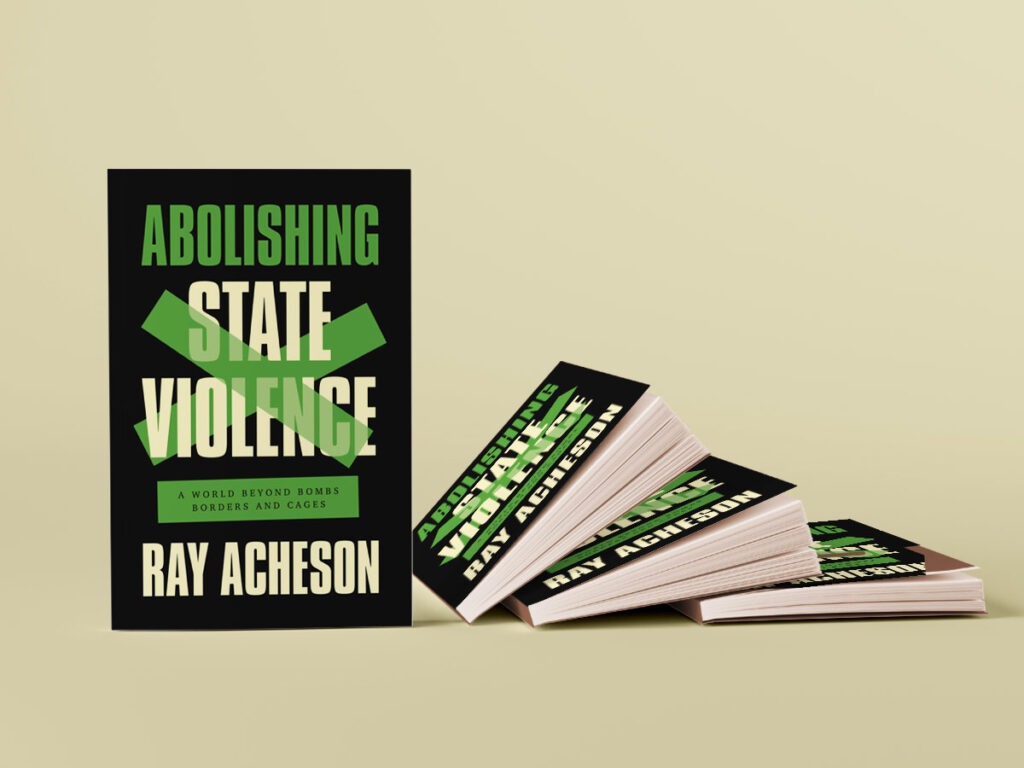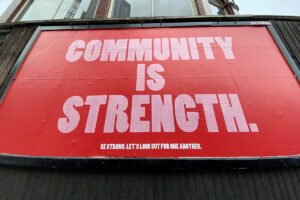
The following is an excerpt from the book, Abolishing State Violence: A World Beyond Bombs, Borders and Cages, by Ray Acheson (pp. 259–265)
Decolonizing and Decarcerating Our Minds
…[I]deas and actions for abolition are surging. In the wake of the growing nightmare created by imperialist governments for migrants around the world; the violent police crackdowns against Black, Indigenous, and other people of color in settler colonial states and against religious and ethnic minorities in many countries; the vast ecological destruction and economic inequalities generated by capitalist exploits and extraction; the impacts of wars and the “national security state”—in the wake of all these and more, people are looking for alternatives. While some turn to reform, pitched by the profiting and profiteering class as reasonable, realistic, and rational, many understand that reform is not going to save us—that we are so far gone that we need to engage in much more ambitious actions to protect people and planet.
The first step is decarcerating and decolonizing our minds from the violent institutions we are told are our protectors—including police, prisons, militaries, weapons, borders, surveillance systems, the capitalist economy—and recognizing that our freedom and well-being lie not with reforming that which oppresses us but with abolishing it altogether.
Abolition is about more than any one of these systems; it is about dismantling the underlying injustice, inequality, racism, militarism, colonialism, patriarchy, heteronormativity, ableism, etc. Being aware of the relationships among all the various structures of violence—which constitute, if you will, a war of the state against people and the planet—enables us to mount more effective campaigns against each of the individual institutions and the collective war machine.
People experience oppression based on the intersections of their many identities and experiences. Thus, the opposition to the sources of oppression also needs to be reflective of these differences and allow these perspectives to inform crosscutting work for abolition. This includes building transnational activism that links anti-war, anti-militarism, and anti-nuclear work with the efforts of those campaigning for economic justice, environmental protection, open borders and migrant rights, anti-racism and anti-fascism, equality, and police and prison abolition. When the war system is considered as a whole, the relationship between these different sites of activism becomes clear.
This kind of thinking and work is already underway. The Abolitionist Platform Toward Healthy Communities established by groups including Critical Resistance, Black Visions Collective, Survived and Punished, The Red Nation, and others calls for “the intersectional efforts of anti-imprisonment, anti-policing and anti-imperialist struggles to coalesce concretely as a response to the COVID-crisis” and beyond.12 Its demands include freedom for all imprisoned and detained people; resistance to surveillance, policing, and militarized responses to COVID-19; access to quality healthcare now and in the future; access to housing, food, and economic security; and international efforts to end US imperialism and militarism.
The Abolishing the War on Terror agenda, put forward by Justice for Muslims Collective, HEART Women & Girls, Vigilant Love, the Partnership to End Gendered Islamophobia, Project South, the Partnership for the Advancement of New Americans (PANA), and the US Campaign for Palestinian Rights (USCPR), draws inspiration from the movement’s demands to abolish ICE and defund the police.13 Promoting a divest-and-invest framework of abolition, it asserts that the call to dismantle the military and the war on terror complex should be part of a broader discussion and organizing for global justice and transformation to provide care, protection, and repair for communities affected by the war on terror in the United States and abroad.
Many Indigenous activists see crosscutting opportunities with environmental activism, pointing out that many of the actions needed to mitigate climate change and protect land, water, and the environment are the same practices of preservation and respect that Indigenous communities have always honored. In response to the promotion of the Green New Deal by environmental and economic justice activists, the Red Nation has proposed a Red Deal14 to ensure this kind of work also leads to decolonization, anti-imperialism, and an end to settler colonialism. Anti-war activists have also noted that the Green New Deal must have antimilitarism at its core, since war and the US military in particular “render impossible the aspirations contained in the Green New Deal.”15
Meanwhile, the Poor People’s Campaign’s efforts to secure a cut to US military spending calls for an end to systemic racism, poverty and inequality, ecological devastation, and militarism and the war economy. Leaders of this campaign have recognized that as demands to demilitarize the police and redirect funds gain traction across the United States, the government needs to reimagine its approach to “national security.” In particular, the Poor People’s Campaign argues, “To create real security, we must slash the Pentagon budget, dismantle the war economy, and invest instead in meeting everyone’s basic human needs.”16 Similarly, US peace group CODEPINK has articulated many of the connections between US wars abroad and at home and argued that defunding the police must be accompanied by defunding war.
There are also synergies in the movements to defund the military and police and those seeking open borders and the right for every person to have the freedom to move or not to move. Just as the Poor People’s Campaign declares that everybody has the right to live, the no borders movement calls for the rights of being a person. In contrast to rights of property, consisting of the right to exclude others from enjoying that which has been privatized, the right of persons consists of the right not to be excluded. Joseph Nevins also describes this right in his appeal for “the right to the world”—a right to mobility and to share our planet’s resources sustainably.17 A no borders politics looks to dismantle the apparatus of border imperialism but is a broader emancipatory project that aligns well with movements to end the prison industrial complex, the surveillance state, and the institutions of weapons and war-making.
The recognition of the connections of these struggles for justice, equity, and well-being of people and planet of course goes back much further than our current time. Since the early days of resistance against settler colonialism, slavery, and segregation, Black and Indigenous organizers have identified the relationships between the violence committed against them and the institutions constructed by the state. They have also articulated and opposed the relationship between this violence at home and the wars of imperialism abroad. Feminists have long articulated the links between the violence of patriarchy and racism at home and abroad and have campaigned against war as the most violent expression of these systems. Since 1915, the Women’s International League for Peace and Freedom (WILPF) has called for the abolition of war and war profiteering, identifying these as patriarchal institutions facilitating capitalist accumulation and global imperialism. WILPF demands that war be made illegal, rejecting armed conflict “as a means of settling differences between people” and calling for “the abolition of private manufacture of and traffic in munitions of war . . . as steps towards total international disarmament.”18 It has always connected these [concerns], divesting from “the crushing burden of armaments” in order “to attack the social and economic problems created by large scale hunger, disease and illiteracy which have been among the prime causes of war.”19
Sign up for our free newsletters
Subscribe to NPQ's newsletters to have our top stories delivered directly to your inbox.
By signing up, you agree to our privacy policy and terms of use, and to receive messages from NPQ and our partners.
This history is important. It offers insights and inspirations into the collaborations that are possible and necessary to overcome the “sophisticated, high-tech system of militarized policing, caging, and borders” that has been built over hundreds of years. Constructing this system, argues Dean Spade, “required changing society so that these ways of seeing and treating each other as disposable are acceptable and normal, producing whole new industries, producing whole new areas of research and knowledge production to support these activities, building the infrastructures of courts and administrative systems and laws, and of course the buildings and cages and fences and tanks and guns and tasers and paddy wagons and the rest.”20 But just as these systems were deliberately constructed, they can be deliberately deconstructed.
Working Beyond Hope
Drawing connections between oppressions, as well as between various sites of resistance to them, is imperative to the process of freeing our imaginations in preparation for building a new kind of world. Once we have imagined a different way of doing things, we must then act to achieve it. We must do this even if it feels like we can’t, or like we won’t make a difference, or that the system is too big, too entrenched, too powerful to ever be overcome.
[. . .]
Our feelings of hopelessness or despair do not afford us the right to abdicate our individual and collective responsibility to at least try to make the world a better place. Instead, we need to work in solidarity with others that are pursuing the same ends. We don’t have to be in relationship with everyone, we don’t have to all do the same work or have the same skills or work against every injustice—but we can support each other and recognize that our efforts take place within a larger community of others working for abolition in a myriad of ways and places.
Hope, in this context, is not necessarily about us as individuals being able to achieve a specific end, but about the ability of us as a collective—including future generations—to drive forward the changes we need to bring justice, safety, and love to humankind and all relations with whom we share our lives on this planet. “Hope about the future and faith in the possibility of change is not something that comes easy,” attests Spade; “it is an active practice based in our principles of winning deep, transformative change rather than system-affirming false victories.”22
The dispossession and displacement created by the structures and systems of violence explored in this series are made through many different processes—settler colonialism, enslavement, occupation, wars, military bases, extraction, economic imperialism, and so much more. This is why solidarity among various abolitionist projects is imperative. As scholar Lisa Lowe argues, because we are working across different oppressions and experiences, “our analytic frames and organising practices likewise cannot be limited to a single logic, issue or national framework.”23 The scope of our vision benefits from a wider lens, even while our actions might be local.
Understanding this “big picture” doesn’t mean we each as individuals need to solve every piece of it. But it does mean we need to recognize and support each other’s efforts and reflect in our own work the analysis and organizing of various movements and projects. The sum of our whole is greater than our parts, and going up again the machine of capitalist violence can feel immense—unless we break it down and rebuild something else, together.
Ruth Wilson Gilmore has noted that so many people and groups are already part of abolitionist projects, many without even realizing it—faith organizations, neighborhood organizations, tenant organizations, artist organizations, prisoner organizations, libraries, environmental justice groups, legal aid providers, transit workers, rights advocates, public health advocates, bail funds, and so many more are actively working to “relieve the stress of organized abandonment” of neoliberal austerity and the capitalist political economy.24 We can add to this list, we can all be a part of it. The work is only overwhelming if we are alone; as [Mariame] Kaba always says, everything worthwhile is done with other people.
It feels, most days, like we are reaching a crossroads. As the pandemic continues to devastate economies and exacerbate inequalities within and among countries; as people try to flee their homelands due to the ravages of climate change, colonialism, capitalism, and conflict, only to be met with border violence, walls, and weapons of detention and deportation; as we see white supremacists taking up their long-stockpiled arms against those standing up for Black lives; as we feel the surging pulse of fascism spread like a virus—as we face all this, we can either succumb to the violence, or we can stand to abolish the systems and structures that enable it. We have nothing to lose but our chains.
Notes:
- “Abolitionist Platform toward Healthy Communities Now and beyond COVID-19,” https://criticalresistance.org/abolitionist-platform-toward-healthy-communities-now-and-onward.
- “Abolishing the War on Terror, Building Communities of Care Grassroots Policy Agenda,” https://www.justiceformuslims.org/grassroots-policy-agenda.
- The Red Nation, The Red Deal: Indigenous Action to Save Our Earth (Brooklyn, NY: Common Notions, 2021).
- Phyllis Bennis, “A Green New Deal Needs to Fight US Militarism,” Jacobin, March 8, 2019.
- Liz Theoharis, “Dismantle the war economy,” openDemocracy, July 19, 2020.
- Joseph Nevins, “The Right to the World,” Antipode 49, no. 5 (2017): 1349–67.
- Women’s International League for Peace and Freedom, “WILPF Resolutions,” 2nd Congress, Zurich, Switzerland, 1919, https://wilpf.org/wp-content/uploads/2012/08/
WILPF_triennial_congress_1919.pdf. - Women’s International League for Peace and Freedom, “WILPF Resolutions,” 12th Congress, Paris, France, August 4–8, 1953, https://wilpf.org/wp-content/uploads/
2012/08/WILPF_triennial_congress_1953.pdf. - Dean Spade and Aaron Belkin, “Queer Militarism?! The Politics of Military Inclusion Advocacy in Authoritarian Times,” GLQ 27, no. 2 (2021), 296–97.
- Spade and Belkin, “Queer Militarism?!,” 301.
- Lisa Lowe, “Afterword: Revolutionary Feminisms in a Time of Monsters,” in Revolutionary Feminisms: Conversations on Collective Action and Radical Thought, Brenna Bhandar and Rafeef Ziadah, eds. (Brooklyn: Verso, 2020), 576.
- Todd Miller, Build Bridges, Not Walls: A Journey to a World Without Borders (San Francisco: City Light Books, 2021), 141.








